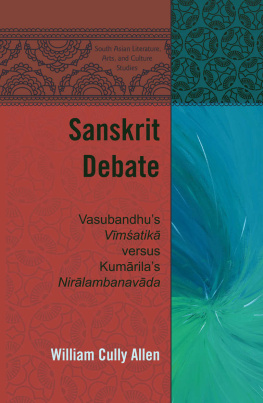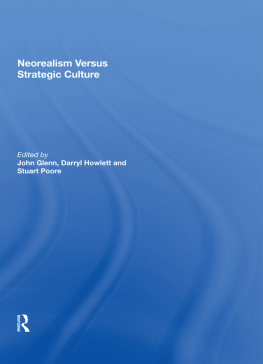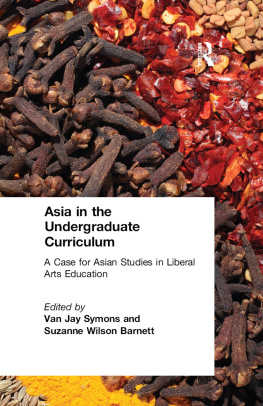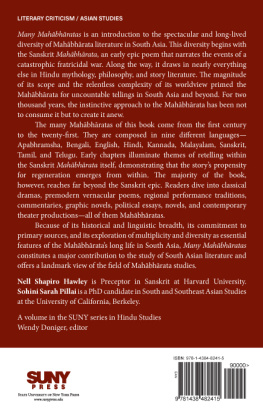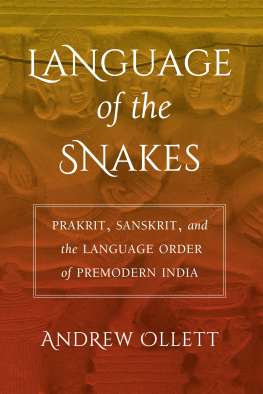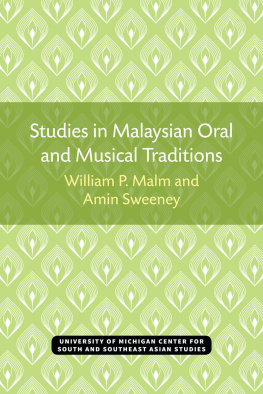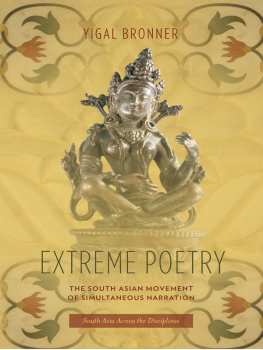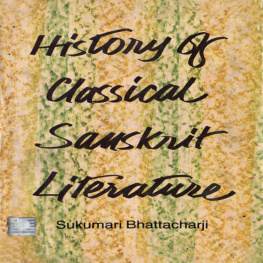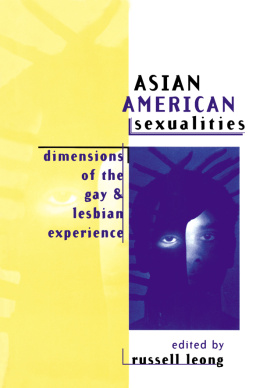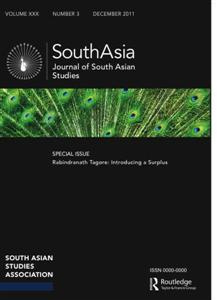South Asian Literature,
Arts, and Culture
Studies
Moumin Quazi
General Editor
Vol. 2
This book is a volume in a Peter Lang monograph series.
Every volume is peer reviewed and meets
the highest quality standards for content and production.
William Cully Allen
Sanskrit Debate
Vasubandhus Vmatik
versus
Kumrilas Nirlambanavda
Library of Congress Cataloging-in-Publication Data
Allen, William Cully, author.
Sanskrit debate: Vasubandhus Vmatik versus
Kumrilas Nirlambanavda / by William Cully Allen.
pages cm. (South Asian literature, arts, and culture studies; vol. 2)
Includes bibliographical references and index.
Includes translations from Sanskrit.
1. ConsciousnessEarly works to 1800. 2. Object (Philosophy)
Early works to 1800. 3. Philosophy, IndicEarly works to 1800.
I. Vasubandhu. Vimsatikavijaptimatratasiddhi. English.
II. Kumarila Bhatta. Nirlambanavda. English. III. Title.
B132. C6A55 181.4dc23 2012045351
ISBN 978-1-4331-1758-9 (hardcover)
ISBN 978-1-4539-0823-5 (e-book)
ISSN 2157-0213
Bibliographic information published by Die Deutsche Nationalbibliothek.
Die Deutsche Nationalbibliothek lists this publication in the Deutsche
Nationalbibliografie; detailed bibliographic data are available
on the Internet at http://dnb.d-nb.de/.
2015 Peter Lang Publishing, Inc., New York
29 Broadway, 18th floor, New York, NY 10006
www.peterlang.com
All rights reserved.
Reprint or reproduction, even partially, in all forms such as microfilm,
xerography, microfiche, microcard, and offset strictly prohibited.
About the author(s)/editor(s)
WILLIAM CULLY ALLEN studied Sanskrit at Harvard University, The University of Pennsylvania, and Banaras Hindu University before earning his Ph.D. in South Asian religion at Temple University. Allen has taught for twenty-five years at Temple University, Austin College, Bucknell University, Muhlenberg College, and the University of the Arts.
About the book
Sanskrit Debate: Vasubandhus Vmatik Versus Kumrilas Nirlambanavda illustrates the rules and regulations of classical Indian debate literature (pramnastra) by introducing new translations of two Sanskrit texts composed in antithesis to each others tradition of thought and practice. In the third century CE, Vasubandhu, a Buddhist philosopher-monk, proposed that the entire world of lived experience is a matter of mind only through his Vmatik (Twenty Verses). In the seventh century CE, Kumrila, a Hindu philosopher-priest, composed Nirlambanavda (Non-Sensory Limit Debate) to establish the objective reality of objects by refuting Vasubandhus claim that objects experienced in waking life are not different from objects experienced in dreams. Kumrila rigorously employs formal rules and regulations of Indian logic and debate to demonstrate that Vasubandhus assertion is totally irrational and incoherent.
Vmatik ranks among the worlds most misunderstood texts but Kumrilas historic refutation allows Vmatik to be read in its own text-historical context. This compelling, radically revolutionary re-reading of Vmatik delineates a hermeneutic of humor indispensable to discerning its medicinal message. In Vmatik, Vasubandhu employs the form of professional Sanskrit logic and debate as a guise and a ruse to ridicule the entire enterprise of Indian philosophy. Vasubandhu critiques all Indian theories of epistemology and ontology and claims that both how we know and what we know are acts of the imagination.
This ebook can be cited
This edition of the eBook can be cited. To enable this we have marked the start and end of a page. In cases where a word straddles a page break, the marker is placed inside the word at exactly the same position as in the physical book. This means that occasionally a word might be bifurcated by this marker.
Table of Contents
| ix
Translating Sanskrit requires learning Sanskrit which cannot be well done without knowledgeable teachers. At Harvard University Michael Witzel taught me Sanskrit grammar. At The University of Pennsylvania, Rosane Rocher trained me to read Classical Sanskrit prose where also Wilhelm Halbfass introduced me to Sanskrit philosophical literature. At Temple University, Bibhuti Singh Yadav supervised my translations of the Sanskrit texts presented in this book, Vasubandhus Vmatik and Kumarilas Nirlambanavda, for which Temple Univeristy awarded me the Ph.D. At Banaras Hindu University, rinarayanmisra read with me both texts in entirety, line by line, several times each, during the final twenty years of his life. I could never have navigated these texts without my teachers. Magistra Cynthia Anne Eberly Allen edited reader friendliness into an otherwise demandingly difficult discourse, Sanjay David produced the index and Professor Stephen Inbanathan formatted the manuscript for publication. I want to also thank Jackie Pavlovic, my production supervisor at Peter Lang Publishing, for her support and Series Editor, Professor Quazi Moumin, for including this work in Peter Langs South Asian Literature, Arts and Culture Studies series.
| 1
In the fourth century of the Common Era, Vasubandhu, a Buddhist from North India, proposed that objects experienced in ordinary everyday waking consciousness are no different from objects experienced in dreams. In a terse twenty-odd verse text, Vasubandhu asserts and defends the proposition that the whole wide world of lived experience is a matter of mind-only. Kumrila, the seventh century champion defender of Mmms, an ancient and enduring Vedic ritual tradition, composed a detailed refutation of Vasubandhus claim. Though several centuries separate Kumrila and Vasubandhu, Sanskrit philosophical discourse unites them in perennial controversy concerning objects of consciousness. Sanskrit Debate demonstrates the terms, methods, and procedures of Classical Sanskrit philosophical disputation in action within two competing texts composed in historical antitheses to each others tradition of thought and practice. The two texts, Vasubandhus VmatikA Collection of Twenty Odd Verses and Kumrilas NirlambanavdaNon-Sensory-Limit-Debateillustrate exactly how philosophical discourse in Classical India was performed. My aim is to make the terms and procedures of Classical Sanskrit philosophical discourse accessible to anyone interested in Indian intellectual heritage.
Reader friendliness is a quality sometimes inherent in books but other times the readers must bring their own friendliness to an otherwise ancient, alien, inaccessible culture of words and concepts. In this way, we, the writer and reader, negotiate a balance of friendliness. There are only two prerequisites for understanding the intricacies of Classical Sanskrit philosophical discourse, namely a sincere desire to know and the capacity to learn. Sanskrit grammarians inform us that words have a special power of their own to yield up their meanings to those who devote their full attention to them. () Sanskrit strangers are introduced in this book as new friends instrumental for mediating new meanings through ancient words.
What do competing systems of Classical Indian philosophy entail and what are they trying to tell us? A world vision entails a position which presents a consistent, comprehensive, coherent construction of meaning. It is a complete system, explaining how to knowepistemologyand what there is to knowontology, addressing such controversial categories as substance, quality, action, relation, time, space, mind, self, intention, memory, and recognition. To have a total coherent vision of life involves taking a position and listening to what others have to say, carefully considering what categories others use to present their views, what criticisms the opponents have, and answering their accusations. Competing systems of meaning are different worlds of discourse 1 | 2 which come face to face in debate. Each position is driven by the need to say something about its world.
Next page
